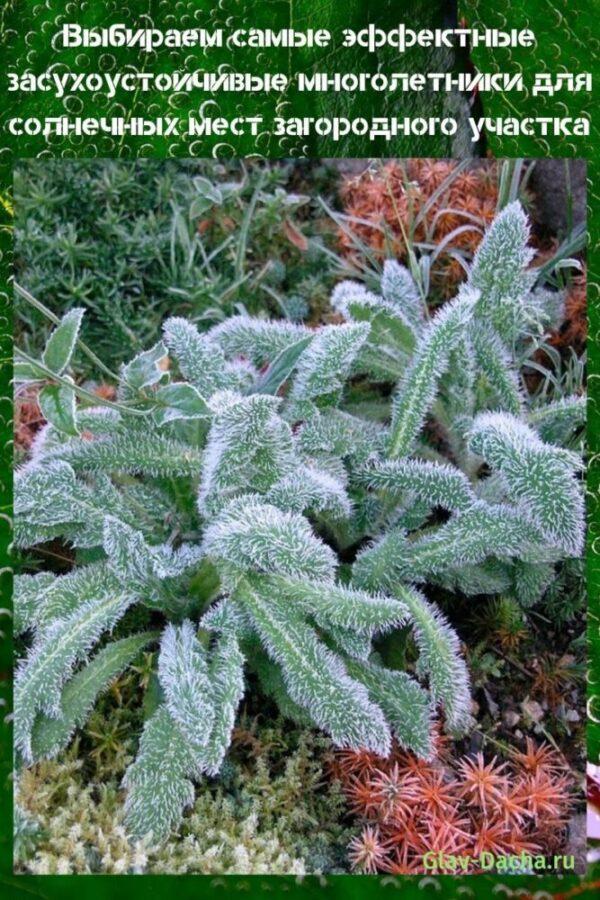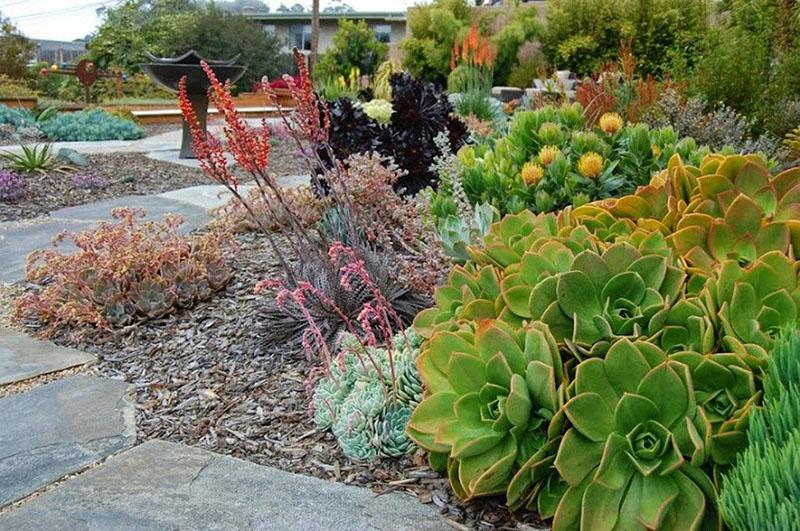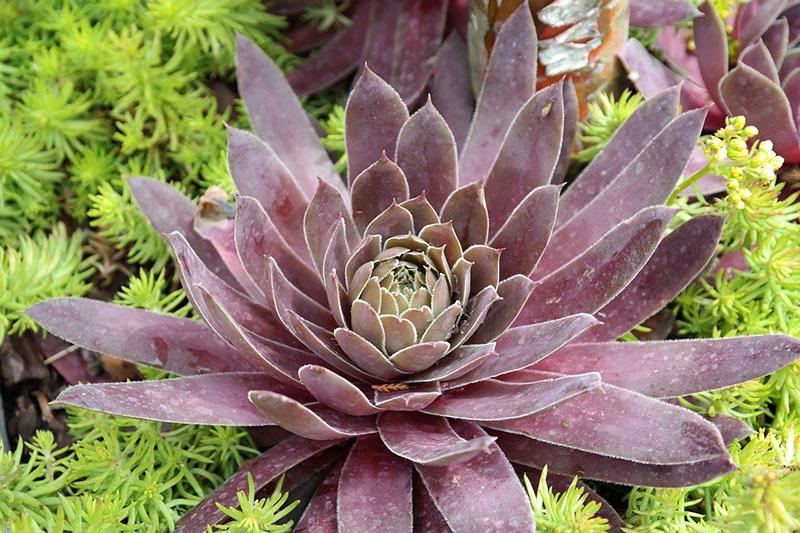We choose the most spectacular drought-resistant perennials for sunny places in a suburban area
 A variety of flowers and green spaces turn the summer cottage area into a wonderful recreation area. To preserve this beauty until fall, experienced designers use drought-tolerant perennials for sunny locations. These amazing crops thrive without additional watering. They are successfully grown by summer residents who go out of town only on weekends. Gardeners have dozens of varieties of these plants. Let's go on an exciting "journey" and choose the most spectacular options for ourselves.
A variety of flowers and green spaces turn the summer cottage area into a wonderful recreation area. To preserve this beauty until fall, experienced designers use drought-tolerant perennials for sunny locations. These amazing crops thrive without additional watering. They are successfully grown by summer residents who go out of town only on weekends. Gardeners have dozens of varieties of these plants. Let's go on an exciting "journey" and choose the most spectacular options for ourselves.
Drought-resistant perennials for sunny places for every taste


Drylands include:
- platforms around the steps leading to the house;
- outskirts of tiled or stone garden paths;
- next to the gate and fence;
- on the terraces.
In addition, it has recently been very fashionable to construct rocky rock gardens... It is convenient to grow drought-resistant perennials on such beds for sunny places that do not need additional watering. Let's get acquainted with the most popular cultures in our area.
Sedum
 The plant is a groundcover succulent. It combines sophisticated attractiveness and extraordinary endurance. Sedum wonderfully withstand dry periods. They are content with moisture, which they accumulate in the sheet plates and receive from the environment.
The plant is a groundcover succulent. It combines sophisticated attractiveness and extraordinary endurance. Sedum wonderfully withstand dry periods. They are content with moisture, which they accumulate in the sheet plates and receive from the environment.
 In addition, the plant grows very quickly throughout the flower bed. As a result, a lush blooming carpet forms on it. It is for this that designers use stonecrops for the background decoration of rockeries and alpine slides.
In addition, the plant grows very quickly throughout the flower bed. As a result, a lush blooming carpet forms on it. It is for this that designers use stonecrops for the background decoration of rockeries and alpine slides.
There are a huge number of varieties of stonecrop:
- thick-leaved (differs in green foliage and yellow buds);

- lanceolate (bushes height about 15 cm);

- false (after the first frost, the plates turn purple);

- multi-stemmed sedum (has pinkish-gray leaves);

- acrid (height about 7 cm, bright yellow buds);

- bent (grows up to 10 cm).

Among tall stonecrops, "Vidny" is considered the most spectacular. It grows up to 70 cm. Its foliage is colored green with a bluish or purple tint. The buds are red, pink and white.
Incomparable tenacious
 A drought-resistant ground cover perennial grows wonderfully in open and sunny areas. He creates dense living carpets with a height of 30 to 50 cm.
A drought-resistant ground cover perennial grows wonderfully in open and sunny areas. He creates dense living carpets with a height of 30 to 50 cm.
Depending on the variety, the buds are:
- snow-white;
- blue;
- pink;
- blue.
The most popular varieties of tenacious are Geneva, Pyramidal, Creeping. The plant does not lose its decorative effect even at a temperature of + 35 ° C, which is kept for more than 30 days.
To plant a tenacious plant in a spacious flower bed, it is enough to purchase a few bushes of the plant.
Gorgeous stone rose
 The plant is an ornamental succulent. Its compact rosette is formed by leaf plates painted in green or purple. In early spring, they accumulate moisture, so they can do without watering all season.During the flowering of a stone rose, a lush greenish bud rises above the rosette.
The plant is an ornamental succulent. Its compact rosette is formed by leaf plates painted in green or purple. In early spring, they accumulate moisture, so they can do without watering all season.During the flowering of a stone rose, a lush greenish bud rises above the rosette.
Bryozoan
 The plant is a spectacular drought-resistant perennial for sunny places, as it easily takes root on rocky soil. Another name for the bryozoan is Irish moss, indicating its tiny size. It successfully fills the space between stones in rock gardens. It tolerates heat, drought, torrential rains, frosts without problems. In the middle of summer, miniature buds appear on the green carpet, which confirms the endurance of the culture.
The plant is a spectacular drought-resistant perennial for sunny places, as it easily takes root on rocky soil. Another name for the bryozoan is Irish moss, indicating its tiny size. It successfully fills the space between stones in rock gardens. It tolerates heat, drought, torrential rains, frosts without problems. In the middle of summer, miniature buds appear on the green carpet, which confirms the endurance of the culture.
Woolly chisel
 The plant is fondly called bunny ears, which it resembles from the side. Large oval leaf plates are covered with numerous silvery villi. Thanks to this, they acquire a soft surface structure. Touching the bunny ears, you get a pleasant feeling of bliss. In summer, the woolly chisel throws out spike-shaped inflorescences, consisting of small buds. They are colored pink, purple and blue.
The plant is fondly called bunny ears, which it resembles from the side. Large oval leaf plates are covered with numerous silvery villi. Thanks to this, they acquire a soft surface structure. Touching the bunny ears, you get a pleasant feeling of bliss. In summer, the woolly chisel throws out spike-shaped inflorescences, consisting of small buds. They are colored pink, purple and blue.
At the beginning of spring, it is advisable to cut the perennial to give it a decorative look.
Subulate phlox
 After planting, the plant forms a lush pillow on the flower bed. It consists of many needle-like leaves. In late May or early June, the subulate phlox puts on a multi-colored “veil” that completely covers the bush.
After planting, the plant forms a lush pillow on the flower bed. It consists of many needle-like leaves. In late May or early June, the subulate phlox puts on a multi-colored “veil” that completely covers the bush.
Most often, the variety is used for planting.and:
- Bavaria;

- Crimson Beauty;

- Candy Stripes;

- Wilson;

- Red Wings.

These drought tolerant garden flowers are sown during the formation of rockeries and alpine hills. Growing up, they form stylish living borders or bright flower curtains.
Paniculate phlox grows up to 150 cm and fits wonderfully into an open flower bed. It also tolerates heat and dry times easily.
Day-lily
 The stylish outfit of these flowers is not affected by the scorching sun and the long absence of precipitation. The key to the sustainability of the culture is the fleshy rhizome underground and the dense foliage outside.
The stylish outfit of these flowers is not affected by the scorching sun and the long absence of precipitation. The key to the sustainability of the culture is the fleshy rhizome underground and the dense foliage outside.
Large buds are painted in such colors:
- Orange;
- red brown;
- pink;
- yellow.
They represent a funnel-shaped bowl, consisting of 6 petals. In the center there are several graceful "tubes". 2-3 buds bloom on the bush at a time. Flowering lasts approximately 25 days.
Stylish varieties can be a wonderful decoration of an open area: Bonanza, Frans Hals, Catherine Woodbury, Hite Bacon.
Echinacea purpurea
 The flower belongs to the Aster family and includes many varieties.
The flower belongs to the Aster family and includes many varieties.
Most often grown in flower beds:
- "Magnus";

- "The King";

- "Grana stem";

- "Zonnenlach";

- "Cranberry Cupcake".

Echinacea grows up to 100 cm in height. Consists of erect shoots with a rough surface. At the bottom, they are framed by a root leaf rosette. Stem plates are lanceolate. The main highlight of the plant is the large inflorescences in the form of baskets, about 15 cm in diameter. The ligulate buds are painted in a purple-pink color, and the tubular ones have a red-brown color. Echinacea blooms for about 60 days regardless of weather conditions (July and August).
The flower is considered a medicinal plant that is used to boost immunity.
Irises
 These humble plants are often called cockerels or orcas. They gained popularity due to their unpretentiousness to weather conditions. Irises belong to flowers that are not afraid of the sun, so they are boldly planted in open areas. There are many varieties of culture.
These humble plants are often called cockerels or orcas. They gained popularity due to their unpretentiousness to weather conditions. Irises belong to flowers that are not afraid of the sun, so they are boldly planted in open areas. There are many varieties of culture.
Most popular options:
- Wine and roses;

- Victoria Falls;

- Royal Opal;

- The Cherry Orchard;

- Flamenco;

- Black dragon;

- Pink ice.

The plant has a tuberous root system located almost on the soil surface. Stems grow in bunches or a single character. Graceful buds of various tones bloom on them in the spring. They come in purple, yellow, blue, pink, brown and white. It is impossible to list all the shades of this humble flower.
Turkish poppy
 Spectacular light-loving flowers for flower beds have always attracted the attention of designers who create gorgeous landscapes.
Spectacular light-loving flowers for flower beds have always attracted the attention of designers who create gorgeous landscapes.
Favorite varieties of Turkish or oriental poppy:
- Allegro;

- Diamond;

- Olympia;

- Fatima;

- Pizzicato.

The Turkish poppy is distinguished by its lush buds of bright red, pink and white. It takes root wonderfully on poor rocky soil. Propagated by seeds that are carried by the wind. Therefore, having planted a crop in one part of the flower bed, the next year they get ready-made flower meadows.
Gelenium
 A tall, drought-resistant flower harmoniously fits into the country landscape.
A tall, drought-resistant flower harmoniously fits into the country landscape.
Designers recommend growing such varieties:
- Cockade;

- Katarina;

- September gold;

- Superboom;

- Altgold.

Large buds of gelenium are colored yellow, red or orange. Flowering begins in August and lasts until the first frost.
The root system of the plant dies off at the end of the season. However, a bud remains in the ground, from which a new plant is formed.
Mountain bells
 Those who are interested in knowing what flowers like heat and sun should pay attention to the marvelous bells.
Those who are interested in knowing what flowers like heat and sun should pay attention to the marvelous bells.
The most famous species:
- Milk-flowered;

- Nettle-leaved;

- Carpathian;

- Broadleaf;

- Pozharsky;

- Portenschlag.

The culture has a double decorative effect. Cute buds and stylish leaf plates. It successfully takes root between concrete slabs, as well as on rocky alpine hills.
Asters
 Everyone's favorite drought-resistant annuals are found in almost every summer cottage. Asters are sown in early spring, and in August and September they decorate open meadows.
Everyone's favorite drought-resistant annuals are found in almost every summer cottage. Asters are sown in early spring, and in August and September they decorate open meadows.
Breeders continue to develop new varieties. Here are the most popular:
- Gait;
- Nostalgia;
- Night;
- Ostrich feather;
- Sam Banham.
In addition, for the middle lane, it is important to grow Alpine aster. She is often called "Frost". After all, it pleases the eye with its buds until the first frost. Perennial aster is planted near concrete curbs, next to a wicket or a fence.
It is good that there are a huge number of drought-resistant crops in nature! Their bud shapes, petal colors and growing patterns are admirable. There is a spectacular option for every gardener. Therefore, we will hasten to sow all open areas where there is an abundance of sunlight.